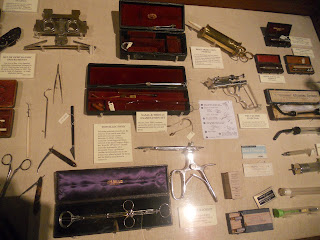Down by London Bridge is the more industrial /businessy area of London. We were down by Southwark and found a few little gems.

I have got to get me one of these.
This nice tour guide was showing me around and I guess she liked me cause she took me into a roped off area in the heart of the cathedral and then said that Shakespeare's brother had attended the church and actually been buried there. I said, "really?!" and she looked at my feet and to my own surprise she was telling the truth and I was standing on him.
A lot of the stained glass windows commemorate different things and this one is brand new. It wouldn't even officially be there until Sunday (the Queen's Diamond Jubilee). The stained glass window was for the Queen and has 60 diamonds in it. The colors are magnificent and it is a really beautiful piece. Now the Queen has her own memento in the cathedral
In the "Sanctuary."
Also in Southwark is the old operating theater. It dates back to about 1815 and is in the attic of an old church (which was actually built next to a hospital). One might wonder why an attic seemed like a good space for operations, nothing like carrying recent amputees down stairs, but the answer is light. A simple gaslamp won't really cut it for surgery so an operating theater needs to be on top of a building and have big big sky lights. There is a small museum next to the theater where the old apothecary used to be.
Ever notice that tools for saving lives look the same as ones to end them?
Kidneys on the right, brain in the back left.
This thing will haunt my nightmares forever.
Charlie is the lucky rapscallion to have his leg amputated. So they don't really use scalpels. Each surgeon would have a set of knives made corresponding to their height and size. Look at that sucker. Its like seven inches long and it is the smallest one. They would actually reach under and around the leg and cut downward. As you can see the conditions are appalling. Everything is made out of wood and the surgeons wouldn't even wash their aprons, which were to keep their suits (they want to look good for this I guess) clean. Rumor was the more stains on your surgeons aprons, the more experienced and skilled he was. They wouldn't figure out about germs and bacteria a while yet and anesthetic wouldn't be invented until 1847, lucky Charlie!
Without any anesthetics you can imagine that the key in surgery is SPEED! Good surgeons could do a full amputation in under two minutes. There was one famous surgeon who had people watching time him and could apparently do them in 30 seconds.
The big thing to remember is at the time people are really, really either Catholic or Anglican. So they have an important belief in the second coming and the resurrection. So everyone is afraid that if they aren't buried properly, all body parts together, on consecrated ground that they can't be resurrected. Now they are beginning to dissect bodies for science (they're still using leeches for pity's sake) but people aren't exactly lining up to donate their bodies to science. So this (and a hundred years or two before) is the age of bodysnatchers. People will dig up fresh corpses and sell them to medstudents. Or doctors will give a family a coffin and they'll open it to find a bag of bricks. Before this some criminals that were sentenced to execution, if their crimes were really bad, were also sentenced to having their bodies given to science. That was considered a fate worse than death. So when you get cut up by a noob they might have sat on the front row of one of these operating theaters a time or two if you're lucky. Its really not shocking to see how little they understood about the human body. People were giving each other TB and London wouldn't figure out the indoor plumbing scene for a while yet so they're still throwing their own waste into the Thames.
A fun fact of our theater is that it was actually a women's theater. Cause its totally inappropriate I guess for genders to be mixed when missing limbs are involved. It was considered indecent for a woman to be stared at by a bunch of male medical students unless she had a blindfold on (cause you know, if she can't see them its totally not happening). Men just had to take it. They might use gin or opiates or chloroform a little later on but as the below picture illustrates, you really just had to take it.
This guy is a scary compendium of knowledge about diseases during 1800 London. I wish I could remember more of his whole schpiel. And doesn't he look so fantastically British?! We learned about gin and poor waste management, black death, blue death, TB, and so much more! Funny part was he finished his tour, we had a round of applause then he says, "do you want me to show you a prostitute's graveyard?" "HELLS YES!" "Woo!" *Assorted excited assent*
Apparently prostitutes used to be buried here and the city has since kind of expanded over it but they don't build on the space and people tie ribbons and jewelery on the gate and have a little service the first Friday of every month or something. Tour highlight much?!













No comments:
Post a Comment